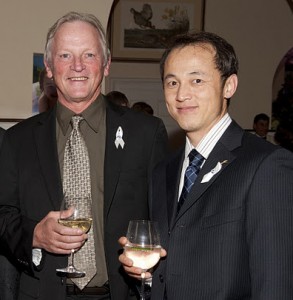2012
Research Story: Dr. Chunguang Guo’s recent publication in Nature
Many congratulations to Dr. Chunguang Guo for publishing a Nature paper in September 2011 !
Dr. Guo obtained his B.S. and M.S in Biochemistry & Molecular Biology from Nankai University in 1999 and 2002. He obtained Ph.D. degree from Western Reserve University in 2009. Since then, Dr. Guo joined Dr. Frederick W Alt’s Lab in Children’s Hospital, Harvard Medical School as a postdoctoral fellow.
An army of immune cells circulates the human body to protect against its potential foes—viruses, bacteria, cancer cells, and other invaders. Because the immune system cannot know what to expect, it must be prepared to fend off virtually any foreign pathogen it might encounter. Now, we have identified a genetic regulator that controls the reshuffling of gene segments that immune cells use to manufacture billions of distinct antibodies and pathogen-recognizing receptors from a limited number of genes.
A typical antibody is a Y-shaped molecule made up of four chains: two identical short chains and two identical long – or heavy – chains. The part of antibodies that we focus on, called the immunoglobulin heavy chain (IgH), is composed of three distinct segments: Variable (V), Diversity (D), and Joining (J). Hundreds of versions of the genes that encode these three segments are scattered throughout the genome, separated by long stretches of DNA. To prepare for antibody production, a developing immune cell stitches together one V segment, one D segment, and one J segment to form a gene that encodes a single heavy chain. Gene reshuffling creates about 100 billion possible combinations of the three segments. While each immune cell will generate many copies of the same antibody, the random selection of gene segments that takes place in each cell generates an assortment of antibodies to equip the immune system to recognize many molecules. However, little is know about how this complicated process is properly regulated, especially in such a huge genomic region.
In his Nature paper (CTCF-binding elements mediate control of V(D)J recombination, 2011, Sept 11;477(7365):424-30. doi: 10.1038/nature10495). Dr Chunguang Guo and his colleagues found that the stretch of the chromosome called IGCR1 is a key to guide proper assembly of antibodies; one way is by bending the chromosome into large loops that bring together distant parts of the antibody gene to produce a huge variety of antibodies. In addition, IGCR1 also prevents excessive recombination of a small number of gene segments located near each other, a sort of local “inbreeding” that would greatly limit the diversity of the immune response. Mechanistically, we found that binding of the protein CTCF to IGCR1 is essential for this delicate regulation. Based on these findings, we proposed a model where IGCR1 is represented as a brick wall, blocking premature V-to-D recombination and preventing recombination of neighboring Vs. The model also proposes that loops are created between IGCR1 and other distant CTCF binding elements, allowing orderly transcription and recombination of Ds and Js while delaying any recombination among Vs.
If anyone is interested in more information, you are welcome to contact Dr. Chunguang Guo via Email: cguo@idi.harvard.edu.
Cheers
HMS-CSSA